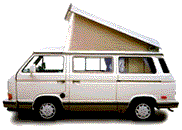Date: Tue, 12 Sep 1995 14:50:04 -0600 (MDT)
Sender: Vanagon Mailing List <vanagon@vanagon.com>
From: Jack Reed <jackr@fortnet.org>
Subject: Starter relay bypass repost
For those that missed it the first time, here it is again...
--
I'd suggest you read this all the way through before you lay finger to
van to familiarize yourself with what you'll need in the way of parts and
the general flow of the work. It's not that it's all that complicated,
it's just that my stream of consciousness style of writing isn't meant to
be an instruction manual but more of a general information guide to the
task at hand. Plus it's a lot less daunting once you've got a picture of
the job in your mind.
Basically what you're going to do by installing a relay prior to the
starter solenoid is to create an amperage amplifier. The wire from the
ignition switch that normally runs to the solenoid will instead be used
to dump voltage/amperage that's very near to the battery's full potential
directly to the solenoid. The reason that you'll be doing this is
because the wiring, connectors, etc. between the ignition switch and the
solenoid have degraded due to corrosion and resistive build up to the
point that not enough current gets to the solenoid to fire it when the
starter is hot. In some extreme cases you won't be able to turn the
engine over even when it's cold.
The solenoid itself can be gotten from Checker (or its equivalent) for
around $5US. Just ask for a generic Ford truck solenoid. It should come
in one of two configurations, either a cross, with the two fat terminals
(outputs) in one plane and two smaller terminals (inputs) in the other plane.
Or the two output terminals are in one plane and the two input terminals
are on one side of the output terminal plane. If you're not sure what's
what ask the counterman (or woman, as the case may be).
I'm going to preface the rest of us this by saying that since this is a
generic document, if things aren't exactly the way I describe on your
vehicle, don't panic, I'm just describing my setup and yours may vary
from it. If you can't figure it out ask the list or write me direct for
advice.
Before you start doing anything at all back by the starter, I'd suggest
that you disconnect the negative battery lead and lay it to the side of
the battery. That way you won't accidently fire the starter, get your
hair, shirt, whatever, stuck in the pulley, get your face ripped off and
your wife, girlfriend, whoever won't sue me for a bazillion dollars for
not warning you about this in the first place. If you don't know enough
to disconnect the electrical system when working on the starter,
alternator, etc., I'm not sure you should attempt this in the first place.
Read the Idiot's Guide for a good primer on basic safety techniques.
Find an appropriate place to mount the solenoid by the starter. If the
only place to attach it is to the starter itself, make sure that it's a
ground point and that vibration won't somehow cause the solenoid to come
in contact with a hot lead (positive 12 volts), usually a red wire. But
not always, so check with a voltmeter if unsure of the wire's polarity.
Remove the wire from the spade clip on the end of the solenoid and attach
one of the post type connectors that you picked up at the same time you
bought the solenoid. Forgot 'em? Better go buy some and take the
solenoid with you to make sure they're the right size. The old wrap the
wire around the post and tighten the nut trick won't work if you want
this to be a trouble-free installation. Pick up a few feet of battery
cable and a crimping tool while you're there. Read on for the rest of
the parts list.
Attach the ignition wire (the one you just removed from the solenoid)
to one of the input terminals, it doesn't matter which one. Then run a
new wire, preferably a black or brown one, to a ground point on the body
from the other input terminal. Once you're sure that everything's tight,
run a fat (8-12 guage, whatever you have) cable from a direct battery
connection to one of the fat terminals. I used the battery connection at
the starter, you can do the same. Then run another new line (also ~10
gauge) from the other fat terminal to the exposed spade clip that the
original ignition wire went to. You can use the original connector, so
long as you didn't cut if off too short and you can use an electrical splice
to connect the two ends.
Several things to make sure of:
Make sure that all connectors, posts, are clean and bright. Polish them
with emery cloth if they're not. Make sure that all your crimp
connections are tight by trying (a bit more than half-heartedly) to pull
them apart. Redo the connection if they are rent (asunder, that is).
Make sure that all screw/nut connections (like the hot lead on the
solenoid) are nice and tight as well.
If you're not sure which of the wires to the solenoid is the one from the
ignition switch, put a volt meter in line between the wire you think is
the correct one and ground. With the volt meter on the Volts setting,
have handy friend temporarily reattach the positive lead to the battery
and turn the ignition key to the start position. If you get
approximately battery voltage, you know you've got the right one. Make
sure handy friend removes the battery cable before proceeding.
I did this to my Rabbit and van about two years ago after experiencing
more and more degradation of the starting system and have had 0 problems
since. I used a Bosch fog light relay on the Rabbit in lieu of the big
Ford solenoid since I didn't think it was necessary (and because I had a
spare one).
Take your time, don't cut your wires until you're sure they're the right
size and you should have a nice, neat installation. Use cable ties to
keep possibly errant wires out of the way of spinning, moving things and
to prevent them from rubbing against sharp metal edges and shorting out
the whole works at midnight in a blizzard after a bachelor party. Hell,
you shouldn't be driving then anyway, go crawl in the back and go to sleep.
;)
Write me if you need more help or clarification,
Jack

